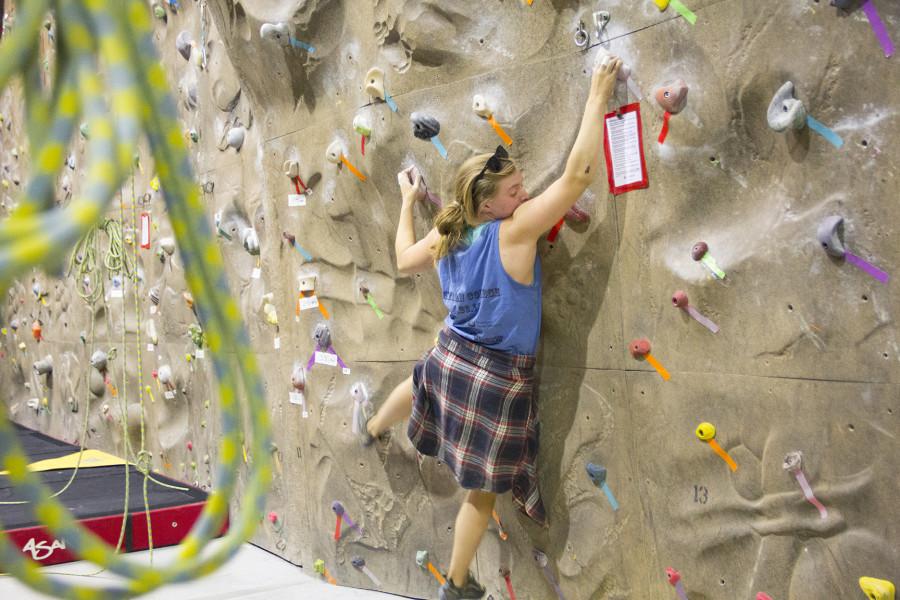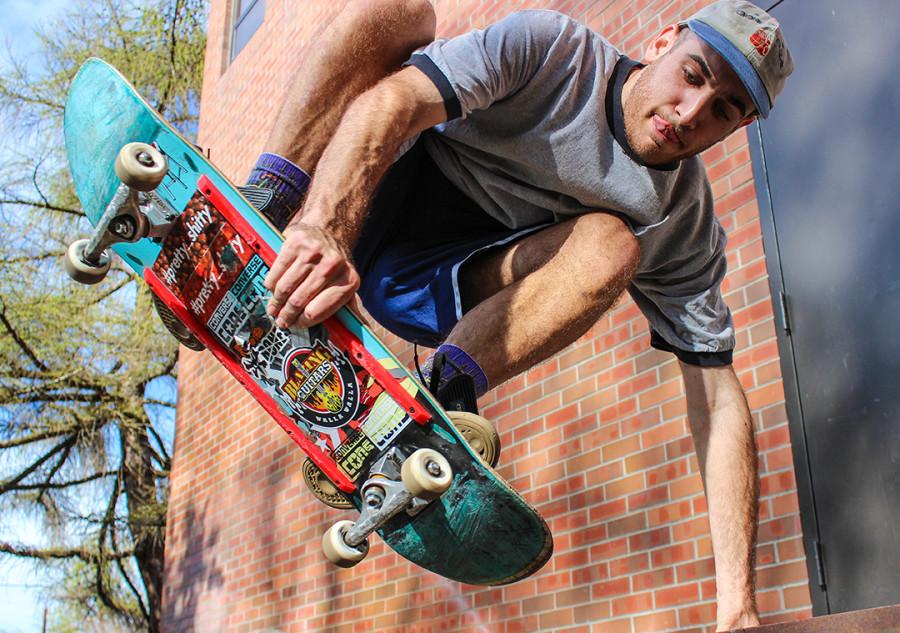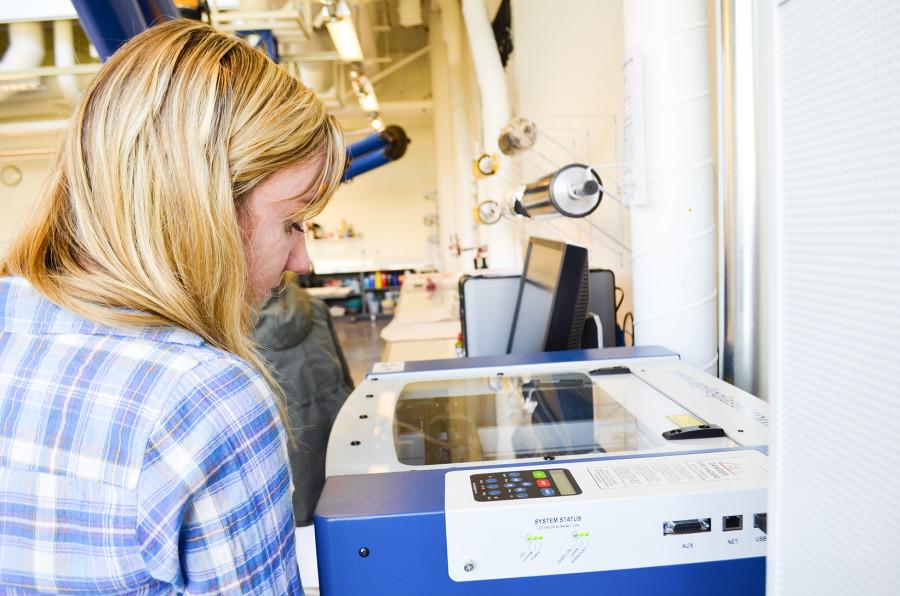Crisp but warm sunshine fills the morning as sophomore Maddie Bailey reverses a maroon pickup truck from the Environmental Interest House (also known as Outhouse) garage. Two Outhouse residents and their resident assistant are on a mission early this Saturday morning. It’s just past 8:30 a.m. as they head out to collect recycling from all the residence halls on campus.
The Outhouse continues the recycling effort it initiated in the 1980s. The interest house was responsible for setting up a recycling system for the entire campus at the time, and consequently its members worked as volunteers to gather recycling. Today, other offices pay employees to take care of waste and recycling around campus. But the Outhouse still serves the residence halls (except Tamarac and the Interest House Community) as an act of community service without receiving compensation for their work.

On this and every Saturday, the back of the truck is filled with blue bins, each one designated for a specific material such as metal cans or paper.
On good days residents gather all the recycling in one trip. Other times they have to come back to the Outhouse’s Recycling Center halfway through the round to empty out their load.
Some residence halls are better than others when it comes to how much and how well-sorted the recycling is. Outhouse recyclers cite Marcus House as one of the easiest places, while the larger halls –– Anderson, Jewett, etc. –– are more difficult because they have far more waste due to sheer number of people.
Today their first stop is the Lyman Hall basement. First they do some basic sorting before picking up the lined green bins and hauling them to the truck three at a time. They sigh in exasperation, eyeing unflattened cardboard boxes.
Bailey picks up a pizza box and points at the greasy cover. It is in the recycling but belongs in the garbage.
They sort through what can be taken back to the Recycling Center and what should be left in the trash can.
“We know what’s going on around campus,” said sophomore Outhouse Resident Assistant Jess Faunt jokingly while rifling through miscellaneous glass bottles before setting them in the pile to be left behind.
Certain things that students may forget to consider when throwing away their stuff can mean significantly extra work for the Outhouse. Breaking down cardboard boxes and dealing with un-emptied containers of beer, milk, soda and yogurt, and the large piles that result when students take out their recycling only once every few weeks, often lengthen the Saturday shift substantially.
In addition to picking up student on-campus recycling, the Outhouse continues efforts to educate students on recycling and the specific items Walla Walla’s recycling plant cannot handle. At the start of every semester, a representative from the Outhouse goes to each residence hall and lays out the ground rules for which materials can and cannot be recycled. This way people are able to put a face to the recycling process.
“I would hope that people could be more intentional with recycling and think about the other side. Somebody is going to sort it and go through all that. [So] rinsing down your containers and breaking down your boxes is huge,” said Faunt.
Though the Outhouse residents do not need to individually sort through the recycling (which they once used to do), they do need to do some basic sorting –– between paper and metal cans, for example. Still, there are others at the Recycling Center who meticulously sort through the materials.
As a resident of the Outhouse, Bailey reflected on how the process of collecting recycling makes her more aware of how taking a little extra time is helpful to those involved in the recycling effort.
“If I had known earlier how it worked, I would’ve helped out more,” she said. While she used to break down her own boxes in the past, she realizes that she could have taken the extra step to flatten other people’s cardboard boxes as well.
In a separate interview, former Outhouse resident assistant and junior Sarah Blacher recognizes how students find it hard to make the small but extra effort to dispose of their recycling properly.
“The thing with students is that we are all in school, a lot of us are working and all of us are busy … and even if they want to do something, where is the time to do something?” she said.
Time and logistics
Here is where the tensions come in. Whitman students are busy, but they are also part of a community that wants to be sustainable and environmentally consciousness. At the same time, there is also the question of how much people know about recycling.
Blacher points out that recycling rules and practices are different from locale to locale. Campus Sustainability Coordinator Tristan Sewell says that as an institution of learning, people with varying levels of sustainability education are coming together in one place. That means not everyone has the same understanding of recycling practices.
Alongside the variety of individual knowledge, recycling systems vary around campus as well.
At the moment, the residence halls, the academic buildings and Reid Campus Center each have their own systems for recycling. While Sewell is working on efforts to create a standard, consolidated recycling system, there is the potential for students to feel confused and pressed for time with a different method wherever they go.
It is then a combination of a lack of time and a lack of a coordinated effort on campus that contributes to the unflattened cardboard and the occasional exploding milk cartons.
“It’s just a very disjointed effort to the movement toward sustainability because I think that students mean well and they do want to be sustainable, but they don’t really know how or they don’t have the time,” said Blacher.
She points out that recycling may seem like a small thing in comparison to renewable energy or water conservation, but it is still part of a whole effort to contribute to Whitman’s environmental consciousness.

In the grand scheme of things, recycling is a small effort, but Sewell argues that recycling has a powerful, symbolic significance.
“It does breed a strong sense of accountability if it is implemented correctly. It’s kind of a gateway to other things. It gets people thinking ‘What other things can I do to reduce my impact?'” he said.
Faunt also shares a similar sentiment.
“It’s important to be aware of what we are consuming and I guess knowing that our actions … that all of our waste has got to go somewhere, and if we aren’t intentional of how we are using that waste, then it might end up in a place we don’t want it to,” she said.
For example, while picking up recycling at Marcus House, Bailey holds up a set of sturdy plastic containers that could be ideal for food or miscellaneous storage.
“We run into a lot of things that we end up keeping because there is a lot that someone else could use or benefit from,” said Faunt. “It’s kind of sad to see we are going through perfectly new cardboard boxes that I ended up taking to help move. There is a lot that we don’t need to get rid of.”
Remember the slogan “Reduce, Reuse, Recycle?” Recycling happens, but there is more work to be done in order to reduce and reuse our waste.
Sewell keeps track of how much waste the college keeps out of the landfill. Last year 55 percent of our potential waste was saved from dumping grounds. Sewell says that this number isn’t too bad, but we could up our game in increasing the number and the materials we recycle in addition to throwing away less, weight wise.
“As kids, I think a lot of people learned to recycle, but there is more than just that stuff. We have to be conscious too,” said Faunt.










Pete • Mar 25, 2015 at 3:03 am
Great work, keep it up!
Pete | https://www.pack-king.co.uk/